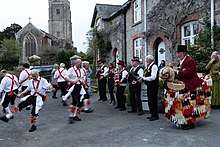Dartington Morris Men
Dartington Morris Men are based in Dartington, near Totnes, Devon, England. The side formed in 1968 at Dartington Hall and is a member side of the Morris Ring. They are a very active side and perform throughout the summer months, starting typically with a May Day dance at dawn and finishing around mid-September. The normal venues for dance are in and around the South Hams of Devon, brightening up the local life with fine performances, followed by great music and song. Dartington Morris is particularly well known for their active Young Morris side, with boys aged between 8 and 14 - a great example of keeping the Morris tradition alive.

In the early days the side practised in the 13th Century "Pillar Studio" at Dartington Hall. Whilst practising and contemplating a name for the side, Leonard Elmhirst, a founder of the Dartington Hall Trust, informed the men that he had once danced the Morris. He suggested that the side call themselves The Dartington Morris Men and use the Dartington crest of a white hart on a red rose, the crest of Richard II and his half-brother John Holland, 1st Duke of Exeter and 1st Earl of Huntingdon (who was given the manor of Dartington for services rendered in battle.)
Two previous Dartington Morris sides are believed to have danced in the Totnes area; one at the end of the 19th century, the other in the 1930s. One of these sides apparently danced in bare feet.
The side kit is based on the colours red, white and gold, derived from the emblem. Male dancers perform to the music of male and sometimes female musicians, with the horse "Champernowne" and a Fool or two adding to the show. They perform mainly traditional Cotswold morris dances and also uniquely perform dances from the lost Filkins tradition, reconstructed by erudite member Christopher Farr.